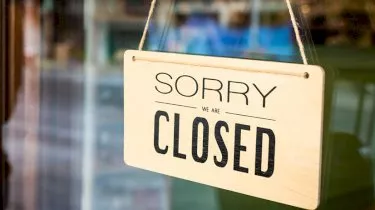Invest
Why a tsunami of insolvencies are coming January 2021
Emergency measures by the federal government could see a wave of business failures at the start of the new year as late payments become the new norm, new research has found.
Why a tsunami of insolvencies are coming January 2021
Emergency measures by the federal government could see a wave of business failures at the start of the new year as late payments become the new norm, new research has found.

CreditorWatch’s latest research has shown that late payment periods between businesses have lengthened to 43 days, meaning businesses are taking 2.9 times longer to get paid.
Despite a lack of cash flow, businesses that are entering voluntary administration have fallen by 60 per cent, as the government continues to let insolvent companies trade.
According to CreditorWatch CEO Patrick Coghlan, this is leading to a rise in zombie firms that will not survive once government handouts cease in January.
“By extending the moratorium to December, the government is wasting taxpayer money by kicking the can down the road. It means that solvent businesses are having to trade with otherwise insolvent debtors, risking their own health, while doomed businesses are able to put off paying creditors or even the ATO,” Mr Coghlan said.

According to the research, finance and insurance companies are the least likely to be paid on time, with a 657 per cent spike in late payments from this time last year.
Transport, postal and warehouse late payments were up 500 per cent to 90 days, while administrative and support services late payments increased 543 per cent to 90 days.
Early this week, Treasurer Josh Frydenberg has confirmed that temporary insolvency and bankruptcy protections that were due to expire at the end of September have been extended until 31 December.
The temporary measures include increasing the threshold at which creditors can issue a statutory demand and initiate bankruptcy proceedings, and provide relief for directors from any personal liability for trading while insolvent.
“These changes will help to prevent a further wave of failures before businesses have had the opportunity to recover,” Mr Frydenberg said.
“The extension of these measures will lessen the threat of actions that could unnecessarily push businesses into insolvency and external administration at a time when they continue to be impacted by health restrictions.
“As the economy starts to recover, it will be critical that distressed businesses have the necessary flexibility to restructure or to wind down their operations in an orderly manner.”
CreditorWatch’s Mr Coghlan believes the government needs to ease safe harbour measures to prevent a “tsunami of insolvencies in January 2021”.
“While Safe Harbour legislation was critical in stabilising the Australian economy as it went into recession, the measures are now becoming counterproductive because they are propping up companies that should be allowed to fail,” Mr Coghlan explained.
CreditorWatch’s chief economist, Harley Dale, pointed out that many businesses are currently thriving and the ones that are not should be allowed to fail.
“CreditorWatch’s monthly Small Business Risk Review paints a stark picture of Australia’s economic landscape. With payment times staying stubbornly high, it’s clear that the SME sector is struggling to generate cash flow outside of government support, indicating that there is a mountain of trouble behind the curtain of stability,” Mr Dale said.
“It sounds harsh, but these businesses need to be allowed to fail so that government focus can be aimed at companies that can stand on their own two feet.”
Mr Dale noted that it is a much bigger problem for the Australian economy than many policymakers realise.
“Winding back Safe Harbour measures, while ensuring borderline companies receive the assistance required from restructuring bodies, are crucial to ensuring Australia passes through the next ‘economic gate’ without taking a massive blow at the beginning of 2021,” Mr Dale concluded.
About the author

About the author


Economy
RBA's hawkish stance reflects inflation concerns, State Street economist comments
In a recent statement, the Reserve Bank of Australia (RBA) has signaled a hawkish stance on interest rates, drawing insights from financial experts about the implications for Australia's economic ...Read more

Economy
Navigating the inflation maze: How CFOs can outsmart economic hurdles in Australia
Fresh inflation data have cooled expectations of near-term rate cuts in Australia, intensifying pressure on margins, capital allocation and demand. Rather than wait for monetary relief that may not ...Read more

Economy
Inflation concerns rise as Australia's CPI climbs to 3.8% in October
Australia's latest Consumer Price Index (CPI) figures have sent ripples through the economy, with headline inflation accelerating to 3.8% year-on-year in October, up from 3.6% in September. The data, ...Read more

Economy
October CPI results pose challenges for RBA’s monetary policy stance
In a surprising turn of events, the October Consumer Price Index (CPI) data has raised eyebrows among economists and market strategists, revealing stronger-than-expected inflationary pressures in ...Read more

Economy
Global deal activity declines by 6% amid economic uncertainty, reports GlobalData
In a year characterised by economic turbulence and evolving market conditions, global deal activity has witnessed a notable downturn during the first ten months of 2025. According to GlobalData, a ...Read more

Economy
Australia’s softening labour market puts another RBA cut in play — here’s what business should do now
A four-year high in unemployment has revived expectations the Reserve Bank could deliver another rate cut as soon as November. With quarterly GDP growth running at 0.6 per cent and annual growth at ...Read more

Economy
Rising CPI reinforces RBA’s stance as rate cut expectations remain: State Street
State Street Global Advisors says the Reserve Bank of Australia (RBA) is likely to hold its current policy outlook following the release of September quarter inflation data, which showed an unexpected ...Read more

Economy
NSW SES boosts tsunami preparedness ahead of World Tsunami Awareness Day
As World Tsunami Awareness Day approaches on 5 November, the New South Wales State Emergency Service (NSW SES) is ramping up efforts to enhance tsunami preparedness along the east coastRead more

Economy
RBA's hawkish stance reflects inflation concerns, State Street economist comments
In a recent statement, the Reserve Bank of Australia (RBA) has signaled a hawkish stance on interest rates, drawing insights from financial experts about the implications for Australia's economic ...Read more

Economy
Navigating the inflation maze: How CFOs can outsmart economic hurdles in Australia
Fresh inflation data have cooled expectations of near-term rate cuts in Australia, intensifying pressure on margins, capital allocation and demand. Rather than wait for monetary relief that may not ...Read more

Economy
Inflation concerns rise as Australia's CPI climbs to 3.8% in October
Australia's latest Consumer Price Index (CPI) figures have sent ripples through the economy, with headline inflation accelerating to 3.8% year-on-year in October, up from 3.6% in September. The data, ...Read more

Economy
October CPI results pose challenges for RBA’s monetary policy stance
In a surprising turn of events, the October Consumer Price Index (CPI) data has raised eyebrows among economists and market strategists, revealing stronger-than-expected inflationary pressures in ...Read more

Economy
Global deal activity declines by 6% amid economic uncertainty, reports GlobalData
In a year characterised by economic turbulence and evolving market conditions, global deal activity has witnessed a notable downturn during the first ten months of 2025. According to GlobalData, a ...Read more

Economy
Australia’s softening labour market puts another RBA cut in play — here’s what business should do now
A four-year high in unemployment has revived expectations the Reserve Bank could deliver another rate cut as soon as November. With quarterly GDP growth running at 0.6 per cent and annual growth at ...Read more

Economy
Rising CPI reinforces RBA’s stance as rate cut expectations remain: State Street
State Street Global Advisors says the Reserve Bank of Australia (RBA) is likely to hold its current policy outlook following the release of September quarter inflation data, which showed an unexpected ...Read more

Economy
NSW SES boosts tsunami preparedness ahead of World Tsunami Awareness Day
As World Tsunami Awareness Day approaches on 5 November, the New South Wales State Emergency Service (NSW SES) is ramping up efforts to enhance tsunami preparedness along the east coastRead more








